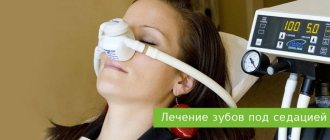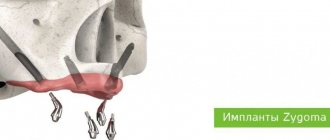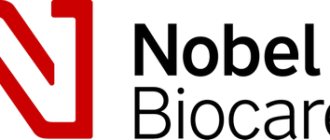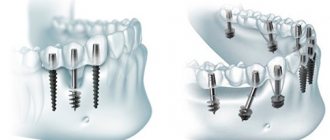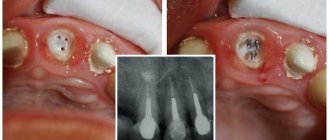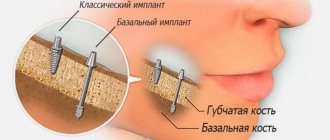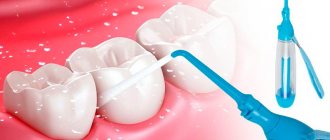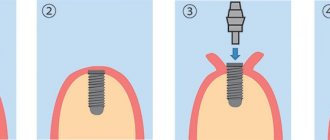One of the fastest methods of restoring a lost tooth is express implantation. The process of installing implants causes considerable anxiety and fear of the painful procedure for many people. In addition, it is generally accepted that this is a rather lengthy process that will require a lot of time and frequent visits to the doctor.
If we talk about classical implantation, then, of course, it will require a certain amount of time, but if you need to quickly install an implant that will hide the absence of one or more teeth, you can resort to express implantation.
The main differences between express implantation and classical methods
Modern technologies and techniques make it possible to make treatment and prosthetics procedures as painless as possible. If you have any problems or diseases, you should consult a doctor as soon as possible to prevent the development of pathologies.
Installation of implants using classical methods requires the presence of bone tissue, but its destruction is a fairly common situation in patients. In some cases, a bone grafting procedure may even be required. The duration of engraftment can be from six to eight months. After which it is already possible to introduce an implant, which will also require time for its engraftment to the bone tissue.
If no complications arise, a permanent crown is installed. Express dental implantation occurs much faster. Sometimes, if the patient does not have any diseases that prevent the operation, the entire procedure can be carried out in a short time, from 1 to 3 days. This is achieved through the use of specially designed mechanisms.
The entire procedure can be briefly described in the following steps:
- examination of the patient for the presence of diseases and the possibility of using the implantation method;
- Under local anesthesia, implants are implanted and impressions are taken;
- fitting and installation of manufactured metal-plastic structures.
The metal-plastic crowns used are installed as temporary elements. Some time after the operation, it is recommended to conduct a re-examination; if the healing process went well and no complications were identified, you can, if desired, replace it with more expensive crowns.
Fast planned installation of implants using navigation templates
The use of templates during implantation allows you to reduce the time for implantation. The video below describes the installation of mini-implants, but the approach is similar to classical implantation.
What are surgical guides? These are plastic structures that are attached to the site where the operation will be performed. Guide holes are pre-drilled on them; special cutters with depth limiters are used to prepare the hole for installing implants.
A few days before the operation, the patient is examined and a three-dimensional study is carried out, the data obtained is transferred to a computer program that creates a model for installing artificial tooth roots. In the program, the doctor determines the optimal location for installing the implant, calculates the angle and depth of insertion. Afterwards, an implantation project is developed, based on which an implantation surgical template is printed on a 3D printer.
Using this template, the surgeon spends no more than 10 minutes to install one implant, while the bone tissue is prepared with minimal trauma. The risks of complications are almost completely eliminated. Read more about the technology here.
Our team of doctors
Maxillofacial surgeon, Implantologist
Bocharov Maxim Viktorovich
Experience: 11 years
Dental surgeon, Implantologist
Chernov Dmitry Anatolievich
Experience: 29 years
Orthopedist, Neuromuscular dentist
Stepanov Andrey Vasilievich
Experience: 22 years
Endodontist, Therapist
Skalet Yana Alexandrovna
Experience: 22 years
Orthopedic dentist
Tsoi Sergey Konstantinovich
Experience: 19 years
Dentist-orthodontist
Enikeeva Anna Stanislavovna
Experience: 3 years
Advantages of express dental implantation
One of the main advantages is the possibility of implantation without bone tissue augmentation. To do this, implants of the correct shape and size are selected. The implementation can be carried out in a minimally invasive way, i.e. by puncture method.
The installed elements are made in the form of a single structure, including the abutment and the implant body, which protrudes above the gum, so it is possible to immediately install a crown. Due to the integrity of the mechanism, the risk of microbial accumulation and inflammation is minimized.
The cost of express implantation in Moscow may vary in different clinics. When choosing a dental center, you should give preference not only to a more favorable cost, but also to pay attention to the choice of qualified specialists. The price of express implantation is not very different from classical methods, however, due to the reduction in the labor intensity of the process and the work of the doctor, it can sometimes be even cheaper.
Implantation and prosthetics All-on-4: price in Moscow
All-on-4 is not a cheap implantation technique. If you decide on All-on-4, the price in Moscow will start from 300,000 rubles (for 2022). This cost will include the installation of 4 Nobel-Biocare implants (Switzerland), as well as the production of a temporary fixed bridge without a metal frame. The option with a temporary bridge on a frame will start from 400,000 rubles. But in a number of clinics you may be offered to save money by making All-on-4 on more affordable Israeli or Korean implants.
The lower price of such implants allows the cost of All-on-4 to be reduced by approximately 50,000 rubles. But such implants perform worse in conditions of insufficient bone volume, and therefore they are rarely used for immediate loading (in the absence of teeth in the jaw). Just 4-5 years ago, almost every clinic offered All-on-4 on economy-class implants - such as MIS, AlphaBio or Osstem. But under conditions of immediate loading, critical bone loss occurred around them already within the first year, which after 3-5 years often even led to the loss of the structure.
Therefore, at the moment (from budget implants), this technique is still sometimes performed on Korean Osstem implants, but only if there is an ideal volume of bone tissue. Let us recall that this means more than 5 mm of the width of the alveolar ridge, and 10 mm or more of the accessible height of the bone tissue. If you have worse results, then saving on implants will increase the risk of a poor outcome with All-on-4. But among non-budget implants, “Straumann” (Switzerland) is also suitable for All-on-4.
All-on-4 price in Moscow (in mid-price segment clinics) –
| Types of implants for All-on-4 | Price , rub) |
| Implants Nobel-Biocare (Switzerland): 4 Nobel-Parallel CC (or Nobel-Speedy Groovy) implants | 1) implantation + temporary adaptive fixed prosthesis without a frame – about 300,000 rubles. Replacement of a temporary prosthesis with a permanent one is carried out after 4-5 months (no later). The cost of permanent prosthetics will range from 180,000 to 550,000 rubles (depending on the type of prosthesis). |
| 2) implantation + temporary adaptive fixed prosthesis on a metal frame – 400,000 rubles. Replacing a temporary prosthesis with a permanent one is carried out only after 2-3 years. The cost of permanent prosthetics is similar. | |
| 3) turnkey All-on-4 implantation: the price below already includes both a temporary bridge on a metal frame and a permanent ceramic-composite bridge on a milled titanium frame - 650,000 rubles. | |
| Implants Nobel-Biocare (Switzerland): 2 Nobel-Zygoma implants + 2 Nobel-Parallel CC (or 2 Nobel-Speedy Groovy) | 1) Implantation + temporary adaptive fixed prosthesis on a metal frame – 500,000 rubles. Replacing a temporary prosthesis with a permanent one is carried out only after 2-3 years. The cost of permanent prosthetics is similar. |
| Options for permanent bridges and their cost will be written in the article below. | |
| Not original implants – | |
| Implants Straumann (Switzerland) 4 implants of the “BLT” or “BLX” series | 1) implantation + temporary adaptive fixed prosthesis on a metal frame – about 400,000 rubles. Replacement of a temporary prosthesis with a permanent one is carried out after 2-3 years. A similar cost for permanent prosthetics is from 180,000 to 550,000 rubles (depending on the type of prosthesis). |
| 2) implantation + temporary bridge on a metal frame, + permanent ceramic-composite bridge on a milled titanium frame – from 650,000 rubles. | |
| Osstem implants (Korea) | 1) implantation + temporary fixed bridge prosthesis on a metal frame – from 300,000 rubles. Replacement of a temporary prosthesis with a permanent one is carried out after 2-3 years. A similar cost for permanent prosthetics is from 180,000 to 550,000 rubles (depending on the type of prosthesis). |
| Options for permanent bridges and their cost will be written in the article below. | |
| 24stoma.ru | |
We once again draw your attention to the fact that it is the Swiss company Nobel-Biocare that is the developer of the All-on-4 implantation technique. Especially for these purposes, she developed models of implants “Nobel-Parallel CC”, “Nobel-Speedy Groovy”, as well as zygomatic implants “Nobel-Zygoma”. In patients with severe atrophy of the jaw bone tissue, zygomatic implants are the last chance for permanent prosthetics. For these implants, the patient’s bone volume is not at all important, because they have an increased length and are installed in the deep parts of the bone.
But zygomatic implants are very difficult to install, and therefore they should only be done by very experienced implantologists with experience in maxillofacial surgery. Otherwise, you may face very serious complications. As for other implant manufacturers, everything will depend on the volume of available bone at the implantation site.
Important: in the price lists of some clinics you can find the following item - “All-on-4 with delayed loading after 4-6 months.” This means that permanent prosthetics with a fixed bridge will only be carried out after 4-6 months, and until then you will have to use a conventional complete removable denture made of acrylic plastic. In fact, this is not an “All-on-4” technique, but a conventional two-stage implantation technique. This All-on-4 technique always involves fixing a fixed bridge in the first days after surgery.
But! You may also consider this implantation option if you are on a tight budget. In fact, it is better to install original Nobel implants and use a removable prosthesis for 4-6 months than to install unsuitable implants and immediately make a temporary fixed bridge. For example, installing 4 Nobel-Biocare implants along with a removable denture will cost you an average of 250,000 rubles. And after 4-6 months it is already possible to make a fixed bridge prosthesis (with a total saving of about 150,000 rubles).
Contraindications
Like any other procedure related to prosthetics, express dental implantation has some contraindications. First of all, the group of restrictions includes diseases of the blood and connective tissues. Due to the fact that the implantation is carried out directly into the bone tissue, if the patient has bone diseases and osteoporosis, the operation also becomes impossible. Before installation, it is recommended to bring the immune system back to normal so that the healing process occurs as quickly as possible and without complications. It is not recommended to perform prosthetics for children and adolescents whose physiological body is still in the process of formation and is not ready for such procedures.
Author:
When is basal implantation used?
Why, then, in Russia did single-phase implantation, also known as basal implantation, not become so widespread earlier? Our independent portal 1dentist.ru found out that this method appeared in Russia when there were a lot of patients who were refused implantation procedures at dentists because they had been missing teeth for a long time and their bone condition had deteriorated significantly.
To restore bone tissue, it was necessary to undergo a long course of plastic surgery to “replant” the bone, as well as sinus lifting and augmentation of bone blocks. In Europe, basal implantation has been actively used since the mid-90s in Germany, Switzerland and France. With the advent of the first trained doctors in Russia, this method became an alternative for hopeless clinical cases.
Patients who had to get used to uncomfortable removable dentures or undergo long-term treatment to restore bones now have the opportunity to get teeth in 3 days!
